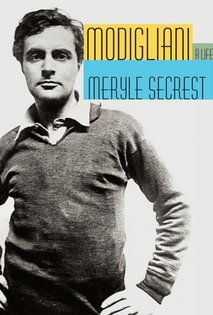
02 Mar 2011 03:24:19
This book is one of those sorts of book, which become popular after author death. Nobody knows how these books become popular and how the editors make them to bestsellers, and if they are interesting - nobody care about the question: why it becomes popular now.
Since the author death at 35 of tubercular meningitis, he has assumed a mythic stature — but not for his art. Rather, he is known in the popular imagination as a drunken, drug-addicted, womanizing exhibitionist whose long-suffering companion, Jeanne Hebuterne, threw herself out a window within days of his death when she was eight months pregnant with their second child.
Now Meryle Secrest, a noted author who has written biographies of Salvador Dali, Frank Lloyd Wright, Stephen Sondheim and others, has taken on the conventional wisdom and delivered a sympathetic reassessment of Modigliani's short, tragic life and his place in the development of 20th-century modern art.
Secrest acknowledges that Modigliani did indeed abuse drugs and alcohol in the years before his 1920 death, but she argues that he was, in effect, medicating himself to soothe a severe cough and mask other symptoms of tuberculosis, which he was diagnosed with as a teenager. She notes that tuberculosis was as much a death sentence then as AIDS was not so long ago, and that Modigliani's circle of artists, art dealers and collectors would have shunned him had they known the truth about his condition.
Secrest appears to have two goals in mind with this book: first, to correct the numerous inaccurate accounts of Modigliani's life that sprang up after his death, and second, to establish that while not as great a talent as Picasso — then again, who was? — he was a bona fide artistic genius.
Born in 1884 at a time of extraordinary technological, political and social upheaval, Modigliani, like so many other foundational figures in modern art, worshipped Cezanne and was deeply influenced by African and Oceanic art.
But unlike the innovators of fauvism, cubism, futurism and the other "isms" of the era, Modigliani insisted on the primacy of beauty, balance and harmony, principles that had ruled Western art since the Renaissance.
In the graceful lines of his swan-neck women and the glowing colors of his famous nudes, Secrest sees a furious attempt to distill the essence of life. Indeed, the apparently simplicity of his forms led to a proliferation of forgeries after his death, a problem exacerbated by the willingness of his daughter — also named Jeanne — to authenticate dubious works.
Since the author death at 35 of tubercular meningitis, he has assumed a mythic stature — but not for his art. Rather, he is known in the popular imagination as a drunken, drug-addicted, womanizing exhibitionist whose long-suffering companion, Jeanne Hebuterne, threw herself out a window within days of his death when she was eight months pregnant with their second child.
Now Meryle Secrest, a noted author who has written biographies of Salvador Dali, Frank Lloyd Wright, Stephen Sondheim and others, has taken on the conventional wisdom and delivered a sympathetic reassessment of Modigliani's short, tragic life and his place in the development of 20th-century modern art.
Secrest acknowledges that Modigliani did indeed abuse drugs and alcohol in the years before his 1920 death, but she argues that he was, in effect, medicating himself to soothe a severe cough and mask other symptoms of tuberculosis, which he was diagnosed with as a teenager. She notes that tuberculosis was as much a death sentence then as AIDS was not so long ago, and that Modigliani's circle of artists, art dealers and collectors would have shunned him had they known the truth about his condition.
Secrest appears to have two goals in mind with this book: first, to correct the numerous inaccurate accounts of Modigliani's life that sprang up after his death, and second, to establish that while not as great a talent as Picasso — then again, who was? — he was a bona fide artistic genius.
Born in 1884 at a time of extraordinary technological, political and social upheaval, Modigliani, like so many other foundational figures in modern art, worshipped Cezanne and was deeply influenced by African and Oceanic art.
But unlike the innovators of fauvism, cubism, futurism and the other "isms" of the era, Modigliani insisted on the primacy of beauty, balance and harmony, principles that had ruled Western art since the Renaissance.
In the graceful lines of his swan-neck women and the glowing colors of his famous nudes, Secrest sees a furious attempt to distill the essence of life. Indeed, the apparently simplicity of his forms led to a proliferation of forgeries after his death, a problem exacerbated by the willingness of his daughter — also named Jeanne — to authenticate dubious works.

